3 questions for...

Prof. Dr. phil. nat. Michael Meyer-Hermann
Director
Prof. Dr. Michael Meyer-Hermann has been working as head of the Department of Systems Immunology at the Helmholtz Centre for Infection Research Braunschweig since 2010. He develops causal models for biomedical systems in order to understand the homeostasis of healthy organisms and their deregulation due to disease or ageing. A major contribution of his research is the development of a simulation tool based on mechanistic principles for the development and generation of specialized antibodies in the organism. The central goal of his research at CAIMed is to optimize medical therapies using quantitative methods from physics, mathematics and engineering.
1.
How do you see the opportunities for development in your field of research through collaboration in CAIMed?
Collaboration with experimental groups has always been at the forefront of our research. We have always formulated our questions with medical application in mind. In CAIMed, we have the opportunity to bring this years of experience onto the medical street.
2.
How important is collaboration between AI experts and healthcare professionals for the success of AI in medicine?
Any form of quantitative, causal or statistical analysis of patient data fails to address the problems of everyday clinical practice if it is not developed in direct interaction with healthcare professionals. This is precisely why we see a great opportunity in the CAIMed consortium.
3.
How do you see the relationship between causal methods and AI in medicine?
Causal methods improve our understanding of the pathogenesis and progression of diseases. This enables targeted interventions to be planned and therapies to be developed effectively. Although AI methods are blind to causal relationships, they can predict disease progression with a high degree of certainty from a large amount of patient data. In order to use personalized medicine for the benefit of mankind, the strengths of both approaches are needed: The most responsive therapy on the statistical basis and the adaptive adjustment of therapies to the response of individual patients on the mechanistic basis. In CAIMed, both approaches are being pursued and it will be important to see them not as opposites but as fruitful complements.

